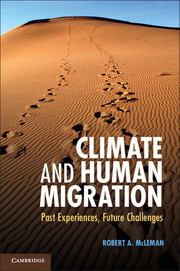Book contents
- Frontmatter
- Dedication
- Contents
- List of Figures
- List of Tables
- Preface
- Acknowledgments
- 1 An Introduction to the Study of Climate and Migration
- 2 Why People Migrate
- 3 Migration in the Context of Vulnerability and Adaptation to Climatic Variability and Change
- 4 Extreme Weather Events and Migration
- 5 River Valley Flooding and Migration
- 6 Drought and Its Influence on Migration
- 7 Mean Sea Level Rise and Its Implications for Migration and Migration Policy
- 8 Emergent Issues in Climate and Migration Research
- Annex Estimates of Global Population Exposed to Tropical Cyclones
- References
- Index
6 - Drought and Its Influence on Migration
Published online by Cambridge University Press: 05 December 2013
- Frontmatter
- Dedication
- Contents
- List of Figures
- List of Tables
- Preface
- Acknowledgments
- 1 An Introduction to the Study of Climate and Migration
- 2 Why People Migrate
- 3 Migration in the Context of Vulnerability and Adaptation to Climatic Variability and Change
- 4 Extreme Weather Events and Migration
- 5 River Valley Flooding and Migration
- 6 Drought and Its Influence on Migration
- 7 Mean Sea Level Rise and Its Implications for Migration and Migration Policy
- 8 Emergent Issues in Climate and Migration Research
- Annex Estimates of Global Population Exposed to Tropical Cyclones
- References
- Index
Summary
Introduction
Droughts are a regularly occurring phenomenon in many parts of the world, and have had adverse impacts on more than a billion people in the past century (Below, Grover-Kopec, and Dilley 2007; see Table 6.1). Most migration that occurs because of drought, or as a means of mitigating the impacts of it, takes place as temporary labor migration, especially in rural populations where household livelihoods and incomes are closely tied to agricultural productivity. Extreme cases, such as distress migrations in dryland Africa of recent decades, tend to occur when the impacts of drought combine with political or economic crises, and are rarely the outcome of drought alone. Although drought-related migration originates primarily in rural areas, a number of urban centers have come perilously close to running short of water during droughts in recent years, presenting a potential future risk for which greater planning and preparation is needed. Droughts are expected to become more frequent and/or severe in many parts of the world in coming decades because of anthropogenic climate change. Recent years have seen global food prices spike in part because of droughts in key grain-exporting areas, suggesting that we are entering an era when droughts will have greater impacts on human well-being generally, even for populations not living in drought-prone areas.
- Type
- Chapter
- Information
- Climate and Human MigrationPast Experiences, Future Challenges, pp. 141 - 179Publisher: Cambridge University PressPrint publication year: 2013



